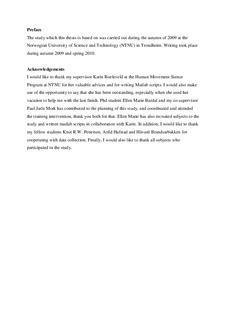| dc.contributor.author | Forsbakk, Camilla Swan | nb_NO |
| dc.date.accessioned | 2014-12-19T14:44:21Z | |
| dc.date.available | 2014-12-19T14:44:21Z | |
| dc.date.created | 2010-11-16 | nb_NO |
| dc.date.issued | 2010 | nb_NO |
| dc.identifier | 370352 | nb_NO |
| dc.identifier.uri | http://hdl.handle.net/11250/271483 | |
| dc.description.abstract | Background: Fibromyalgia syndrome (FM) is associated with widespread pain over the entire body. Moreover, an impaired muscle function is frequently reported in FM patients. Several causes are supposed to cause these impairments, and causes can be multiply. However, the results are inconclusive.
Objective: To investigate why women with FM have an impaired muscle function.
Material and methods: Fifty women in the age 35-65 participated in an intervention study existing of 12 weeks indoor cycling. Twenty-five women with fibromyalgia (FM) and 25 women without FM (controls) were compared at baseline and post exercise. Outcome measures included pressure pain threshold (PPT), maximal voluntary contraction (MVC) force, rate of force development (RFD) and ipsilateral matching response. MVC, RFD and ipsilateral matching response was measured in shoulder abduction and knee extension.
Results: Women with FM had significantly (P<0.05) lower PPT, MVC and RFD compared to healthy controls in both upper and lower body. Moreover, the pain ratio between upper and lower body was similar in both groups. After 12 weeks of indoor cycling both groups had a significant (P<0.05) increase in MVC and RFD in the knee extensors. Small changes in PPT might have occurred, but no significant (P>0.05) changes were present for groups separately. The women with FM and the healthy controls responded similar to the training. In the ipsilateral matching response there were no significant (P>0.05) differences between groups at baseline, and after 12 weeks training there were no significant (P>0.05) changes in either group.
Conclusion: We suggest that impaired strength and RFD in women with FM is not due to pain. Lower extremities are more affected with impairments compared to upper body. In addition, our results suggest that possible disturbances in central mechanisms in women with FM do not inhibit training induced increase in strength and RFD. Moreover, it seems like pain have not resulted in impairments in proprioception in women with FM.
Key words: Fibromyalgia – women - pain- aerobic exercise- muscle performance- maximal voluntary contraction- MVC- Rate of force development- RFD- ipsilateral matching response- pressure pain threshold – PPT | nb_NO |
| dc.language | eng | nb_NO |
| dc.publisher | Norges teknisk-naturvitenskapelige universitet, Fakultet for samfunnsvitenskap og teknologiledelse, Institutt for bevegelsesvitenskap | nb_NO |
| dc.title | Impaired muscle function in women with fibromyalgia is not due to pain. | nb_NO |
| dc.type | Master thesis | nb_NO |
| dc.contributor.department | Norges teknisk-naturvitenskapelige universitet, Fakultet for samfunnsvitenskap og teknologiledelse, Institutt for bevegelsesvitenskap | nb_NO |
